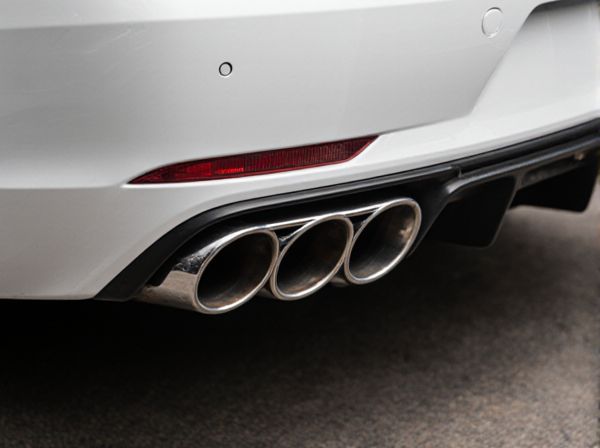
Photo illustration: Mandrel-bent vs Crush-bent
Mandrel-bent tubing maintains its original diameter and shape throughout the bend, ensuring a smooth inside radius that prevents kinking or deformation, making it ideal for applications requiring consistent flow and strength. Crush-bent tubing, in contrast, involves compressing the tube during bending, which can lead to flattened sections and weaker structural integrity, often used in less critical or aesthetic applications. Choosing the right method impacts Your project's durability, fluid dynamics, and overall performance depending on usage requirements.
Table of Comparison
| Feature | Mandrel-Bent Exhaust | Crush-Bent Exhaust |
|---|---|---|
| Bend Quality | Smooth, consistent diameter | Ovalized, reduced diameter |
| Performance | Improved exhaust flow | Restricted flow, potential turbulence |
| Durability | High, less stress on metal | Lower, prone to cracking |
| Cost | Higher price | More affordable |
| Application | Performance and custom exhausts | Standard factory exhausts |
Introduction to Exhaust Pipe Bending Methods
Mandrel-bent exhaust pipes maintain consistent diameter and smooth inner walls by utilizing a mandrel inserted during bending, which prevents deformation and enhances exhaust flow. Crush-bent pipes, formed without internal support, often experience flattening or kinks, affecting performance and exhaust gas dynamics. Choosing mandrel bending improves durability and airflow efficiency, while crush bending offers cost-effective shaping for less demanding applications.
What is Mandrel-Bent Tubing?
Mandrel-bent tubing is a manufacturing process where a solid rod, or mandrel, is inserted inside the tube to maintain its shape and diameter during bending, preventing collapse or deformation. This technique ensures uniform wall thickness and a smooth, precise bend, making it ideal for applications requiring tight-radius bends and optimal flow characteristics, such as automotive exhaust systems and aerospace components. Compared to crush-bent tubing, mandrel bending preserves the tube's structural integrity and enhances durability under stress.
What is Crush-Bent Tubing?
Crush-bent tubing is a method where the tube is bent using conventional dies that compress and flatten the tube walls, often resulting in oval-shaped bends and potential wrinkling. This technique is less expensive and simpler than mandrel bending but can compromise flow efficiency and structural integrity due to deformation. Crush-bent tubing is commonly used in applications where precise shape and smooth internal surfaces are less critical, such as basic exhaust systems or non-critical fluid transport.
Structural Differences Between Mandrel-Bent and Crush-Bent
Mandrel-bent tubing maintains a consistent diameter and smooth curvature due to a supportive internal mandrel during bending, preventing deformation and wrinkling. Crush-bent tubing, by contrast, lacks this internal support, resulting in flattened areas and irregular shapes at the bend, compromising structural integrity and flow characteristics. The key structural difference lies in the precision and uniformity of mandrel bending versus the potential distortions inherent in crush bending processes.
Impact on Exhaust Flow and Performance
Mandrel-bent pipes maintain a consistent diameter throughout bends, minimizing turbulence and preserving optimal exhaust flow for enhanced engine performance. Crush-bent pipes often experience diameter deformation at bends, restricting exhaust flow and reducing engine efficiency. Selecting mandrel-bent tubing supports improved horsepower and torque by ensuring smooth, unrestricted exhaust gas movement.
Durability and Longevity: Mandrel vs Crush
Mandrel-bent tubing maintains consistent diameter and wall thickness throughout bends, significantly enhancing durability by preventing structural weaknesses and cracks over time. Crush-bent tubing often experiences wall thinning and deformities in tight bends, leading to increased risk of failure and reduced longevity. Mandrel bending provides superior resilience in high-stress applications, making it the preferred choice for long-lasting, high-performance tubing systems.
Cost Comparison and Affordability
Mandrel-bent pipes offer superior flexibility and precision but come at a higher production cost due to specialized tooling and slower processing times. Crush-bent pipes, while less precise and prone to deformation, are more affordable as they use simpler equipment and faster manufacturing methods. For projects prioritizing budget constraints, crush-bent options provide a cost-effective solution, whereas mandrel-bent is suited for applications where quality and durability justify the higher investment.
Installation and Application Scenarios
Mandrel-bent pipes maintain a consistent diameter and smooth curvature, making them ideal for applications requiring uninterrupted flow, such as automotive exhaust systems and high-performance fluid transfer. Crush-bent pipes may experience deformation and reduced cross-section, suitable for less critical structural installations where precise flow dynamics are not essential, like certain HVAC ductwork or low-pressure plumbing. Installation of mandrel-bent pipes demands specialized equipment to preserve pipe integrity, while crush-bent pipes are easier to fabricate on-site but may require additional reinforcement to prevent leaks or weaknesses.
Pros and Cons: Mandrel-Bent vs Crush-Bent
Mandrel-bent pipes maintain consistent diameter and wall thickness throughout bends, reducing flow restriction and minimizing stress points, making them ideal for performance exhaust systems. Crush-bent pipes are more affordable and easier to produce but suffer from wall deformation and reduced internal diameter, which can cause turbulence and decrease exhaust efficiency. While mandrel bends offer superior airflow and durability, crush bends are suited for budget applications where precision performance is less critical.
Choosing the Right Bending Method for Your Vehicle
Mandrel-bent exhaust pipes maintain a consistent diameter throughout bends, ensuring optimal exhaust flow and performance, which is ideal for high-performance and turbocharged vehicles. Crush-bent pipes are more cost-effective but feature a flattened section at bends that can restrict airflow, making them suitable for standard or budget builds without demanding performance needs. Selecting the right bending method depends on your vehicle's performance goals, with mandrel bending preferred for maximizing power and efficiency, while crush bending fits basic applications prioritizing affordability.
 caratoz.com
caratoz.com